 Cambodian traditional silk ikat weaving was on the brink of extinction when a Japanese craftsman Kikuo Morimoto found out about it and decided to master this craft. He created a community where artisans from different regions of Cambodia live, work, and teach. This is a story that shows us that the proverb “No man is an island” is wrong – one person can influence the whole country’s culture. Every single artisan matters in the context of traditional crafts.
Cambodian traditional silk ikat weaving was on the brink of extinction when a Japanese craftsman Kikuo Morimoto found out about it and decided to master this craft. He created a community where artisans from different regions of Cambodia live, work, and teach. This is a story that shows us that the proverb “No man is an island” is wrong – one person can influence the whole country’s culture. Every single artisan matters in the context of traditional crafts.
This story is told by Kikuo Morimoto, the Japanese Master Artisan specializing in painting kimono. He created the Institute of Khmer Traditional Textiles that popularizes Cambodian ikat weaving. Kikuo Morimoto gathered the artisans from various corners of Cambodia and organized a community where they live, work, and teach.
So, let’s listen to his story.
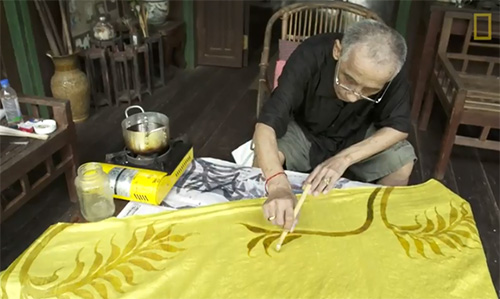
Kikuo Morimoto at work
Let's say, it's something that arises from deep inside of me. This desire to draw. I guess drawing, and I mean expressing by art, is in my nature.
I was working in kimono in Kyoto, and I saw many fabrics. But I never saw Cambodian Ikat textile. I never saw it before.
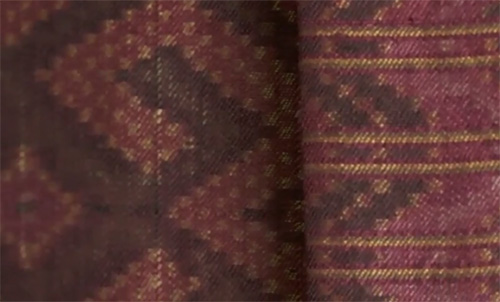
Cambodian ikat patterns
But when I went to a museum in Thailand, there was Cambodian ikat in the exhibit. When I saw it, I was very surprised by its detail, its beauty, but above all, I felt the energy of the person who had made it – through the textile. And I couldn't move. This was my first encounter with the Cambodian textile.
Cambodian ikat is at least as old as the Angkor Dynasty (802-1431). By the time Morimoto learned of ikat, the ancient art form had nearly disappeared.
I couldn't forget that fabric. And I came to visit Phnom Penh for the first time in 1994. I was surprised that the civil war was not yet finished. And in the town, some people still have the gun. This is my first impression of Cambodia.
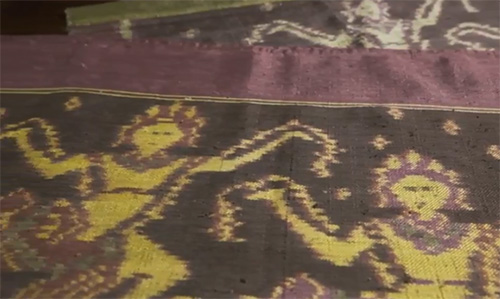
Cambodian ikat patterns
Starting in the late 1960s, Cambodia experienced a period of war, famine, and genocide. During this time, many cultural sites and art forms were destroyed.
I happened to meet with these elderly weavers. And this might be a strange way to say it, but they were loving and very kind. Feeling that kindness from the Cambodian people might have been the beginning. And this made me want to start working on regenerating these old techniques with these grandmas.
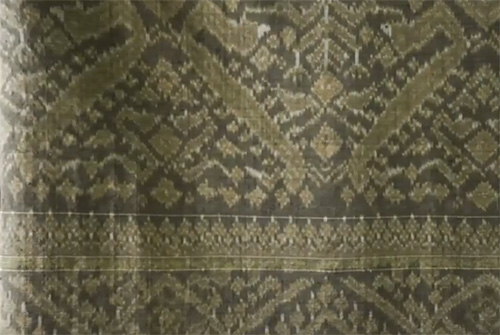
Cambodian ikat pattern
In Cambodia, people have been weaving for a very long time. To make these intricate patterns, you need to tie the thread, so certain parts don't get dyed and maintain the original color. By repeating this, you make designs in the thread. Weaving these threads creates textiles with patterns.
Banana leaf is tied around the thread prior to dyeing. This controls how the silk is colored. The weavers tie, dye, and weave these intricate patterns completely from memory.
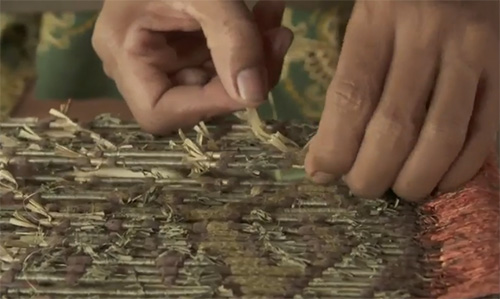
Process of tying the threads before dyeing the fabric
I started this project because I really wanted to recreate Cambodian textiles. In order to do that, I started raising silkworms and then plants for different pigments, invited the weavers to join me – and I realized we had formed a village.
By looking now, you can't tell, but there was nothing here. I planted the seeds and they grew to be a forest. Each of these plants has their own color, and we get our colors from the plants.

Wooden frame used during tying the threads before dyeing
Morimoto is a master of natural dyeing, using only naturally occurring ingredients. He boils things like bark and leaves, allowing nature to speak through color.
For me, God is in nature. Like, God is in the trees, in the soil, and in the mountains. Those are the gods in nature. This is my God.
I named this community “Wisdom of the forest”. We learn traditional knowledge from the villagers. And we built a community making full use of these traditions, experiences, and techniques.

Bobbins of threads for weaving
It’s like a school. I call it “Life of the school”. Kids can study how to make the fabric. How to dye, how to tie, and how to design.
In other words, I consider it a school of life, where kids can naturally learn how to work and live. That's what, I think, this community is. I learned about the kimono from the ground up. I started from zero, learning how to draw in two years, three years, five years, and then, at the tenth year, I became a master. This is how it is in an artist world. And since that is how I experienced it, I always work with them. I want them to take their time and, hopefully, in ten years, they, too, will become masters. I feel I have raised these weavers just like I raised the trees. These weavers, who grow up from seeds, are now weaving wonderful textiles.

Process of weaving Cambodian ikat
Now, they have the chance to work here and they get a place for living and eating, and they get a salary. And I feel they're happy. And also I'm happy, too. Now, I give it to the next generation to continue this project. You know, this village is my work. It’s like drawing a picture. For me, it’s the same. I dreamed up the landscape, the picture, my drawing, and it happened for real.
Kikuo Morimoto died in 2017. But his legacy is still with us. He left us the knowledge about Cambodian ikat. He taught people not only how to make Cambodian textiles but also how to love and treasure it.
(c)


